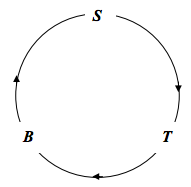15.3: Adiabatic Demagnetization
( \newcommand{\kernel}{\mathrm{null}\,}\)
We are now going to do the same argument for adiabatic demagnetization.
We are going to calculate an expression for (∂T/∂B)S. The expression will be positive, since T and B increase together. We shall consider the entropy as a function of temperature and magnetic field, and, with the variables

we shall start with the cyclic relation
(∂S∂T)B(∂T∂B)S(∂B∂S)T=−1.
The middle term is the one we want. Let’s find expressions for the first and third partial derivatives in terms of things that we can measure.
In a reversible process dS=dQ/T, and, in a constant magnetic field, dQ=CBdT. Here I am taking S to mean the entropy per unit volume, and CB is the heat capacity per unit volume (i.e. the heat required to raise the temperature of unit volume by one degree) in a constant magnetic field.
Thus we have (∂S∂T)B=CBT.
The Maxwell relation corresponding to (∂S∂P)T=−(∂V∂T)P is (∂S∂B)T=(∂M∂T)B. Thus Equation ??? becomes
(∂T∂B)S=−TCB(∂M∂T)B.
Now for a paramagnetic material, the magnetization, for a given field, is proportional to B and it falls off inversely as the temperature (that’s the equation of state). That is, M = aB/T. and therefore (∂M∂T)B=−aBT2=−MT. Equation 15.3.2 therefore becomes
(∂T∂B)s=MCB.
You should check the dimensions of this equation.
The cooling effect is particularly effective at low temperatures, when CB is small.


